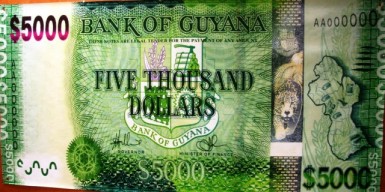Financial analyst Christopher Ram says while there is justification for a higher denomination, a $2,000 note would have been a better idea and he also cautioned that with the imminent arrival of the $5,000 bill its inflationary potential is real although not certain.
The new $5,000 bills are slated to go into circulation on December 9th and though some sections of society such as the city chamber are welcoming this development others have expressed mixed feelings.
Calls for the introduction of the $5,000 bill, much larger than the current $1,000 bill, go back several years, and the Georgetown Chamber of Commerce and Industry (GCCI) had even called for a $10,000 bill.

The bill was unveiled on November 15th, 2014 by Finance Minister Ashni Singh and Deputy Governor of the Bank of Guyana (BoG) Gobind Ganga.
On Thursday, the GCCI voiced its support for the bill, contending that it will reduce “the amount of notes required to carry out transactions and this is particularly welcomed for those individuals and companies that are engaged in large financial exchanges,” among other things.
But Chartered Accountant Ram envisages that the introduction of the note, while good in some regards, will usher in some unfavourable effects, and instead suggested that maybe a $2,000 bill might have been more practical. He said on Thursday that while the BoG has argued that the introduction of the new note will not cause inflation, the classical theoretical school of thought among economists teach that “an increase in money supply without a corresponding increase in goods and services leads to price inflation.”
In 2012, during a GCCI organised seminar, BoG Governor Lawrence Williams played down concerns about increased inflation as a result of the introduction of the $5,000 bill.
He had said that the notion that the introduction of the higher currency note will lead to inflation is a misnomer, since the circulation of the new note does not necessarily increase the money supply in the economy.
He also noted that inflation “actually fell” during earlier periods when larger currency notes were introduced into the economy, and added that the introduction of the new $5,000 note was simply a matter of “shifting dependency from the $1,000 note to the new, larger denomination.”
Addressing this particular argument, Ram on Thursday said that when the $1,000 bill was introduced in 1996 (an earlier version of this news item had incorrectly listed the year as 2007), the inflation rate was 4.5% and the economy grew by 7.9%. Moreover, he said that the highest note was increased from $500 to $1,000, which was a 100% increase.
When the note goes into circulation on December 9th, the move will constitute an increase of 400%, and this, Ram said, is happening at a time when the economy is not growing as fast. Ram is of the opinion that these factors signify that the potential for inflation is real, although he conceded that it is not certain.
Williams had also explained that international currency principles mandate that the highest denomination of a country’s currency account for around 20% of total currency notes or 60% of the value of money in circulation.
In Guyana, though, this is not the case. As of 2012, he said, the $1,000 bill accounted for 59% of the quantity of currency notes in circulation and around 94% of the total value of money in circulation. Ram says that this amount of $1,000 bills account for around $63 billion of the $67 billion currently in circulation.
The fact that Guyana seems to be “enamoured” with high notes is an indication that there is heavy hoarding, particularly in the less formal economy, Ram suggested. He also said that if the BoG releases a high number of $5,000 notes without withdrawing other lower notes, “we may witness a huge spike in the number and value of currency, with further implications for inflation.”
Aside from the debate among the financial professionals, though, concerns loom among venders, taxi and minibus operators, and other business operators who deal largely with small notes. Stabroek News spoke with several taxi and bus drivers who are not at all looking forward to being paid by a passenger with a $5,000 bill.
One driver said that some “inconsiderate passengers” are in the habit of intentionally paying with large ($1,000) bills very early in the morning because they know most of the buses are now starting out for the day and would not have change.
As a result, he said, he does not want to imagine what will happen when the new note comes out, especially since the law states that all legal tender is acceptable for transactions of all natures.
Ram, recognising the fear of such operators, said that these fears “may be exaggerated but are not without merit.”
“There is a problem with the value of the next lower denomination being $1,000; the need for a large stock of $1,000 will remain substantial to give change when someone tenders a $5,000 bill for an $800 purchase,” he said.
He also pointed to a contradiction in the move away from a cash economy. Pointing out that one of the arguments for the new note is portability, Ram said that the people who are being facilitated with the $5,000 can easily afford a bank account, credit card and debit card.




